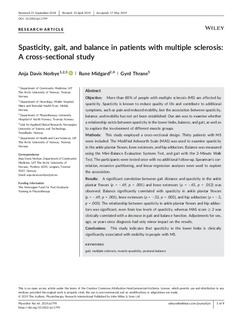| dc.description.abstract | Objective
More than 80% of people with multiple sclerosis (MS) are affected by spasticity. Spasticity is known to reduce quality of life and contribute to additional symptoms, such as pain and reduced mobility, but the association between spasticity, balance, and mobility has not yet been established. Our aim was to examine whether a relationship exists between spasticity in the lower limbs, balance, and gait, as well as to explore the involvement of different muscle groups.
Methods
This study employed a cross‐sectional design. Thirty patients with MS were included. The Modified Ashworth Scale (MAS) was used to examine spasticity in the ankle plantar flexors, knee extensors, and hip adductors. Balance was measured using the Mini‐Balance Evaluation Systems Test, and gait with the 2‐Minute Walk Test. The participants were tested once with no additional follow‐up. Spearman's correlation, recursive partitioning, and linear regression analyses were used to explore the association.
Results
A significant correlation between gait distance and spasticity in the ankle plantar flexors (ρ = −.69, p < .001) and knee extensors (ρ = −.45, p = .012) was observed. Balance significantly correlated with spasticity in ankle plantar flexors (ρ = −.69, p < .001), knee extensors (ρ = −.52, p = .003), and hip adductors (ρ = −.5, p = .005). The relationship between spasticity in ankle plantar flexors and hip adductors was significant, even from low levels of spasticity, whereas MAS score ≥ 2 was clinically correlated with a decrease in gait and balance function. Adjustments for sex, age, or years since diagnosis had only minor impact on the results.
Conclusions
This study indicates that spasticity in the lower limbs is clinically significantly associated with mobility in people with MS. | nb_NO |

